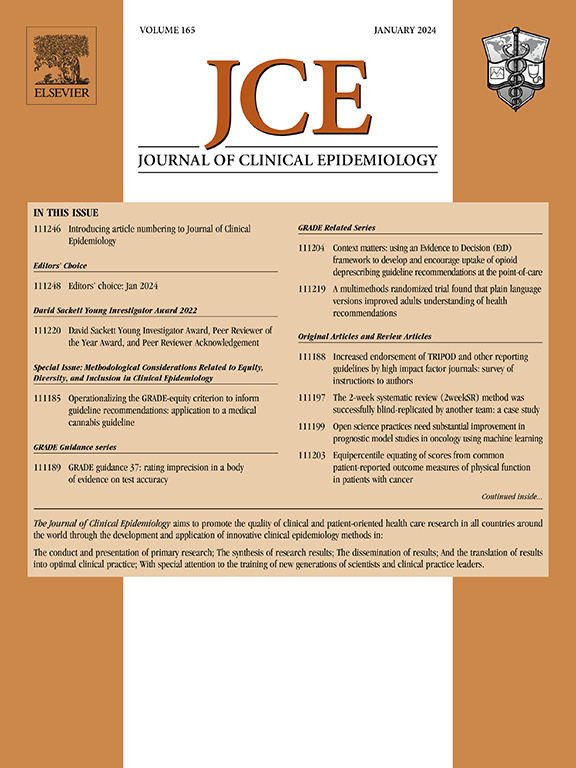模拟研究表明,在随机对照试验中,线性回归和Mann-Whitney检验可用于分析存活和在家30天(DAH30)的结果。
IF 7.3
2区 医学
Q1 HEALTH CARE SCIENCES & SERVICES
引用次数: 0
摘要
目的:从统计学角度考虑DAH30的特性,并进行模拟研究,探索使用简单(未调整)线性回归和Mann-Whitney检验作为分析方法,反映实现的分析选项。研究设计和设置:第30天存活和在家的天数(DAH30)已被提出为以患者为中心的指标,并且是适合临床试验的临床相关指标。它具有不同寻常的统计特性,标准统计分析方法的适用性尚不清楚。综述了DAH30的性质。在基于经验数据的随机对照试验(RCT)中进行了基于1:1分配的模拟,模拟了不同添加剂(反映DAH30)的处理效果、样本量以及中心位置和零值水平的分布。使用各种度量来评估性能(包括偏倚、覆盖率、拒绝率)。结果:线性回归对加性处理的未调整平均处理效果提供了有效的估计。这在偏差、方差估计、没有效应时的拒绝率和真实实现效应的95%置信区间的覆盖率方面得到了证实。在某些情况下,Mann-Whitney提供了比线性回归更大的(功率)。结论:在零通货膨胀率相对较低的RCT队列(即治疗意图或“治疗政策”估计)中,简单线性回归是DAH30估计平均治疗效果的合理分析选择。在某些情况下(小的影响和较小的样本量),曼-惠特尼检验提供了更好的能力(同类对同类)来检测组之间的差异。本文章由计算机程序翻译,如有差异,请以英文原文为准。

A simulation study showed that linear regression and Mann-Whitney test can be used to analyze the days alive and at home by day 30 outcome in a randomized controlled trial
Background and Objectives
The aims of the work were to consider the properties of the days alive and at home by day 30 (DAH30) from a statistical perspective, and to conduct a simulation study exploring the use of simple (unadjusted) linear regression and Mann-Whitney test as the method of analysis reflect realized analysis options.
Study Design and Setting
The days alive and at home by day 30 (DAH30) has been proposed a patient-centric outcome, and clinically relevant outcome suitable for clinical trials. It has unusual statistical properties, and suitability of standard statistical analysis methods is unclear. The properties of DAH30 were reviewed. Simulations based upon 1:1 allocation in an randomized controlled trial (RCT) based upon empirical data were conducted reflecting different additive and realized (reflecting the DAH30) treatment effects, sample sizes and distributions with varying and central locations and zero value level. A variety of metrics were used to assess performance (including bias, coverage, and rejection rate).
Results
Linear regression provided a valid estimate of the unadjusted average treatment effect with an additive treatment. This was confirmed in terms of bias, estimation of variance, rejection rate in the absence of an effect, and coverage of the 95% confidence interval for the true realized effect. Mann-Whitney provided greater (power) than linear regression in some situations.
Conclusion
Simple linear regression is a reasonable analytic option for the DAH30 for estimating the average treatment effect in the RCT cohort (ie, an intention to treat, or “treatment policy” estimand) where zero-inflation is relatively low. Mann-Whitney test in some circumstances (small effects and smaller samples sizes) provides better ability (like for like) to detect a difference between the groups.
Plain Language Summary
Simple linear regression can be used to analyze DAH30 outcome in a randomized trial for a range of scenarios which were considered in this study (including relatively proportions of zero values). The DAH30's properties affect the treatment effect than can be estimated. Mann-Whitney test offered better ability to detect a difference of a smaller magnitude for smaller samples sizes.
求助全文
通过发布文献求助,成功后即可免费获取论文全文。
去求助
来源期刊

Journal of Clinical Epidemiology
医学-公共卫生、环境卫生与职业卫生
CiteScore
12.00
自引率
6.90%
发文量
320
审稿时长
44 days
期刊介绍:
The Journal of Clinical Epidemiology strives to enhance the quality of clinical and patient-oriented healthcare research by advancing and applying innovative methods in conducting, presenting, synthesizing, disseminating, and translating research results into optimal clinical practice. Special emphasis is placed on training new generations of scientists and clinical practice leaders.
 求助内容:
求助内容: 应助结果提醒方式:
应助结果提醒方式:


